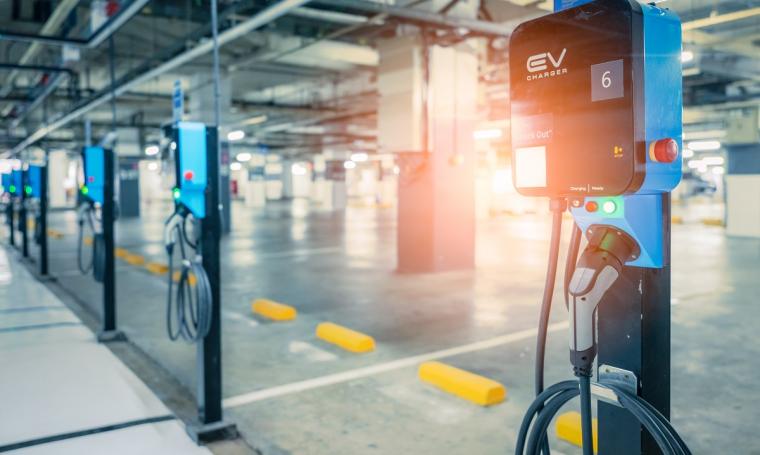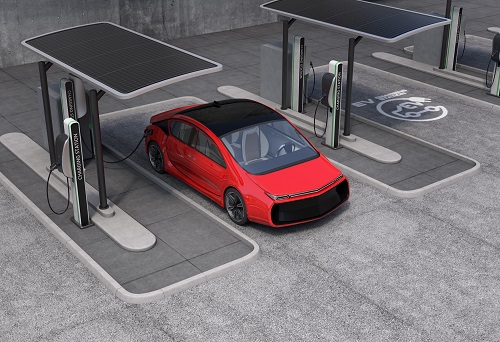
Sports and entertainment venues are at the forefront of the sustainability movement. Many venues are leading the way for buildings of all kinds with successful waste reduction and recycling, alternative energy and water efficiency programs. As electric vehicles (EVs) ascend in popularity — they’re expected to account for 40% of all car sales by 20301 — offering EV charging stations is a logical next step. And there’s good reason to invest in them.
Venue attendees care about sustainability. Roughly two-thirds of American sports fans say that green energy is the future, and 40% say they try to only buy from socially and environmentally responsible companies.2 Offering EV charging further demonstrates your commitment to sustainability, and it can help attract attendees who may otherwise stay home or choose another method of transportation.
Additionally, local and state authorities are passing building codes that require newly constructed buildings to include EV charging stations. It’s not a stretch to assume that, eventually, these mandates could extend to existing facilities as well.
The benefits of EV charging stations are straightforward, but implementation can be challenging. Here’s what venue operators need to know.
1. Prioritize the fan experience
Your vision for the EV charging experience will help inform decisions about pricing, promotion, and logistics down the line. Because EV charging can be time-consuming — the fastest chargers available today can take up to an hour to deliver a full charge — there are a few ways you can approach your offering:
- Allow fans to use an EV charger for the duration of an event. This means they can be sure to get a full charge, and no one will have to move their vehicle.
- Use valets to turn over vehicles at charging stations. This allows you to offer charging to more fans and generate more revenue. The challenge is logistics. Since you can’t always predict how long an event will run, and how much time vehicles need to charge, you may not be able to guarantee everyone access to a station. Careful coordination and communication between valets and fans are essential.
- Offer access to chargers outside of events. This can further maximize revenue. However, without an event to occupy customers’ time, you may want to consider amenities like vending machines, Wi-Fi, or a seating area.
For the first two options, you can make the process even more seamless by allowing fans to bundle parking with their event ticket.
2. Prepare for scalability
EV charging requires you to implement new systems and infrastructure. To avoid a time-consuming, disruptive retrofit down the line, you need to consider how much energy demand your initial and future EV charging stations will require. Here are some factors to consider to ensure a scalable energy infrastructure:
- What is your current electrical service capacity and demand?
- How much do you anticipate charging stations will be used, particularly at peak times?
- Do you have future plans for grid-interactivity (where onsite renewables and the public energy grid are used interchangeably)?
Outside of your energy infrastructure, it’s also important to consider the subsystems for EV charging and associated amenities. All of your features and services should connect with an integrated technology platform that enables you to manage operations from a single tool and deliver a more seamless experience.
3. Set competitive rates and communicate them clearly
Determining the fee structure for EV charging can be tricky since you want to balance revenue generation with convenience and transparency for fans. You can charge for time, kWh used, or by the space itself. Since some event attendees may have pre-purchased parking, it’s important to clearly communicate if EV charging comes at an additional cost so there are no surprises.

To optimize revenue, you can implement dynamic pricing. With dynamic pricing, charging rates fluctuate based on demand, time of day, and other factors. Fans pay for the true value of the space, instead of a set rate that may feel arbitrary to them. For example, you can charge more during a major concert, and less on non-event days. Again, it’s important to communicate rate fluctuations clearly with signage, your website, and your app.
EV chargers can help draw in fans who may have otherwise chosen public transit or ridesharing to get to an event. And offering access outside of event days can help boost parking revenue. To reap these benefits, it’s important to get the word out about your charging stations and any related amenities. To reach potential fans where they are, consider a multi-pronged approach:
- Add signage outside of the lot or garage indicating that EV charging is available. Electronic signage allows you to share dynamic information, such as rates and the number of spaces available.
- Sell EV access and parking reservations along with event tickets.
- Get listed on parking aggregator apps and include clear details on pricing and availability. Some aggregator apps cater specifically to EVs, allowing you to get the word out further.
- Run marketing campaigns through multiple channels, such as email, social media and even direct mail, to keep your EV charging stations top of mind for potential fans.
- Offer frequent purchase programs to encourage loyalty.
5. Report and analyze on performance
EV charging stations offer a treasure trove of data that you can harness to improve operations and monitor your progress towards goals. You can track KPIs for usage, revenue, and sustainability. Depending on the solution you choose, you can even monitor energy consumption and adjust loads when needed.
The key here is to capture the right data and make it actionable. Depending on the demands of your particular facility, what that looks like may vary. While advanced analytics and controls can be valuable if you need them, these systems usually come at a higher price point, and there’s no need to pay for bells and whistles that you won’t use. Understanding what analytics and controls you truly need will help you find the ideal solution.
6. Evaluate external partners
Implementing EV charging is a team effort, and identifying the ideal solutions and partners is essential. If you choose to work with an external installation partner, choose an expert electrical contractor with the following EV charging expertise:
- Ability to weigh costs, building codes, user demand and your electrical capacity
- Knowledge in creating EV charging ecosystems with hardware and software that integrates with your technology and your physical infrastructure
- Experience working with the local electric utility to advise you on potential rebates and incentives and evaluate whether your charging infrastructure will affect power distribution equipment
Some EV charging installation experts offer best-in-class charging stations and software as part of their solutions, which allows you to streamline the number of vendors you work with.
Thoughtful implementation pays off
While the implementation process can be challenging, getting it right pays off in smooth operations. The expertise of your installation team makes all the difference. Working with an external partner that also has venue parking expertise can help you incorporate EV charging into your overall facility plan. The right partner will know how to optimize dynamic pricing, marketing strategies, and signage so you can maximize the full return on your investment.
Demand for EV charging is only going to grow. By building a harmonious parking ecosystem, you can meet the needs of fans today and set the foundation to scale effectively in the future.
Sources:
1. Charging into the future: the transition to electric vehicles
2. Global Sports 2022: Uncovering the Socially Responsible Sports Fan

